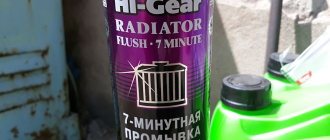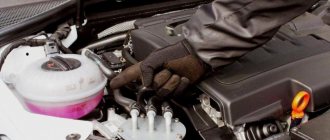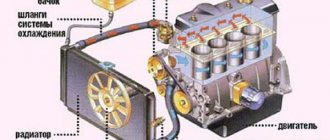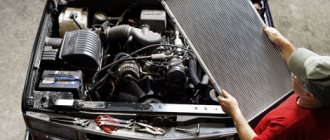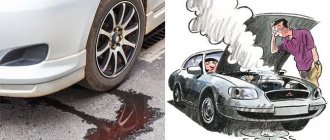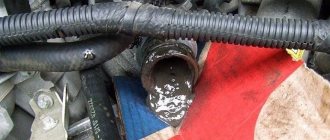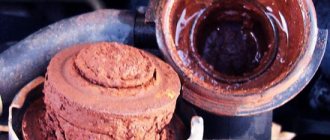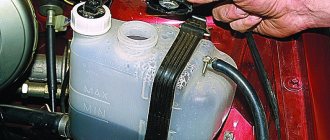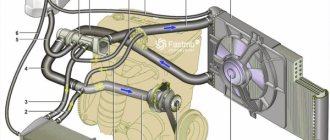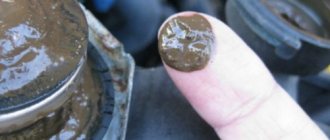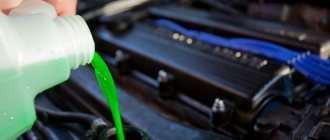07 August 2017 Lada.Online 50 726 0
During long-term operation of the vehicle, the engine cooling system may become clogged. The presence of dirt contributes to insufficient circulation of coolant in the system. As a result, the engine begins to overheat, and the efficiency of the stove decreases. To eliminate the occurrence of these malfunctions, the engine cooling system should be flushed.
The instructions for cleaning the engine cooling system on all modern LADA cars (XRAY, Vesta, Largus, Granta, Priora, Kalina, Niva 4x4) are similar. There are no fundamental differences.
What is not recommended for flushing the cooling system?
Among the so-called folk remedies, there are a number of those that are not recommended for use, despite the fact that some car owners still use them, and in some cases they even help. Let's give a few examples.
Coca-Cola
Using Coca-Cola as a Cleaner
Some motorists use Coca-Cola to flush the cooling system of oil, emulsion, scale and rust. The fact is that it contains orthophosphoric acid, with which you can easily get rid of the mentioned contaminants. However, in addition to acid, this liquid contains large amounts of sugar and carbon dioxide, which can lead to certain problems.
If you decide to use Cola as a cleaning liquid, it is better to first release carbon dioxide from it so that during the expansion process it does not harm individual engine components. As for sugar, after using the liquid, you must thoroughly rinse the cooling system with plain water.
Also remember that phosphoric acid can harm plastic, rubber and aluminum parts of the cooling system. Therefore, “Cola” can be kept in the system for no longer than 10 minutes!
Fairy
Some car enthusiasts use the popular household grease cleaner Fairy or its analogues to flush the cooling system of oil. However, its use is associated with a number of problems. Firstly, its composition is designed to combat dietary fat, and it simply cannot cope with motor oil. And even if you try to pour it into the radiator, you will have to fill and “boil” the engine several dozen times.
Therefore, we DO NOT recommend that you use household grease removers like Fairy and similar products.
Calgon and its analogues
Calgon, Tiret and similar products are not recommended for cleaning radiators, since their intended purpose is to remove limescale deposits on water pipes.
"White"
The peculiarity of “Belizna” is that it contains sodium hypochlorite, which corrodes aluminum. And the higher the temperature of the liquid and the working surface, the faster corrosion occurs (according to the exponential law). Therefore, under no circumstances should you pour various stain removers into the system, especially those containing bleach and compounds based on it (including “Mr. Muscle”).
"Mole"
Known in narrow circles, “Mole” is made on the basis of caustic soda. Accordingly, they cannot be used to treat aluminum radiators and other surfaces. It is only suitable for cleaning copper radiators (in particular, stove radiators) and only by removing it and running such a cleaner through the system will you kill all the rubber seals and seals.
Other mixtures
Some car enthusiasts use a mixture of citric acid (25%), soda (50%) and vinegar (25%) for cleaning. However, we do not recommend that you do the same, since it is very rough and corrodes rubber and plastic parts.
These cleaning agents are only permissible if you need to flush the stove radiator and you do not plan to circulate liquid throughout the cooling system.
How to repair a car
The cooling system performs important functions, namely removing excess heat from the engine. To remove heat, forced circulation of coolant through the system is used. Engine coolant has its own working life and must be replaced after a certain number of kilometers or time. After the expiration date, the coolant loses its properties, which is reflected in the overall performance of the engine. The service life of the coolant is usually indicated on the packaging label.
How does coolant perform its functions?
To perform the functions required of the coolant, a number of chemical additives are added to it, each of which has its own task. During operation, the coolant is affected by both heat and metal particles, which leads to the loss of important properties of the coolant. Such an effect makes the coolant unsuitable for use. Therefore, this coolant must be replaced.
What happens if you don't change the coolant?
It is best to follow the timing of replacing the coolant in the engine cooling system. And experienced technicians advise not to delay replacing the coolant. There is no need to wait until a brown coating appears on the walls of the expansion tank, which indicates the presence of a decomposition product of coolant additives.
If you do not change the coolant on time, this will lead to increased wear of engine parts, spot or local overheating of parts, and rapid wear of cooling system parts.
Where to start replacing the coolant?
First of all, find the vehicle's technical manual and select the required coolant recommended by the manufacturer.
If you do not find such information, you should consult a specialist or choose a coolant based on harmless carboxylate additives (not so aggressive to the engine).
On sale you will find diluted coolant or concentrate. If you take concentrate, you should stock up on distilled water.
Coolant replacement work.
Let's get started with replacing the coolant:
- Drain the old coolant. Before draining the coolant, you need to prepare everything for draining the coolant (an old basin, or cut the canister into two parts).
- Place a container under the drain hole and unscrew the drain plug (if you are draining oil from a hot engine, beware of burns).
- After draining the old coolant, you need to screw the drain plug back into its original place (radiator tap), depending on what you removed.
- If the cooling system is heavily contaminated, the cooling system should be flushed with a special engine flush (it may happen that there are microcracks in the radiator that have been clogged with dirt; when flushing it, a leak will appear). Therefore, before flushing, correctly assess the technical condition of the cooling system.
- Unscrew the plugs to let air out of the system, and fill in coolant until liquid flows out of the plug holes, then immediately tighten the plugs (such actions will help you avoid air pockets in the system). Air locks in the cooling system can be determined by the release of cold air from the stove.
- One of the ways to get rid of an air lock in the cooling system is to maintain high engine speeds of 2000-2500, which will ensure increased coolant circulation in the cooling system.
- If you decide to flush the cooling system, then after filling with distilled water, tighten the cap of the expansion tank and start the engine, wait for the engine to warm up.
- When the engine warms up and the fans come on, wait for them to turn off and turn off the engine.
- Wait until the coolant cools down to a safe temperature. Drain the coolant.
- Fill with fresh coolant (antifreeze).
- Make a note to yourself when you changed the coolant.
The effect of flushing the cooling system with Coca-Cola
Another completely unusual solution is to rinse the SOD with Coca-Cola, but for some reason it seems strange to many that the drink can corrode dirt. But there is still an explanation for this chemical reaction: the “soda” contains orthophosphoric acid (acidity regulator). According to some drivers, Coca-Cola actually helps to wash the inner walls of the radiator and is not the worst flushing agent. But before using this composition, you must open the bottles of liquid and wait until the gas is completely released from them.
For rinsing, the Coca-Cola drink is not diluted with water, it is filled entirely, which means that to refill a 10-liter PO you need to buy five large bottles of lemonade. But is it worth experimenting with such an unusual product for a car, when there are a lot of proven compounds, as well as certified products specifically designed for these purposes?
Leaks and problems
Cars of this model sometimes have problems associated with the failure of some parts of the cooling system, such as a thermostat or pump. If they break down, they are replaced as an assembly, fortunately they are not expensive. Also, leaking hoses or a cracked expansion tank are considered a common problem, which also needs to be replaced.
But there is another problem with the VAZ 2105, a leaking heater valve. Because of this, there may be a smell of antifreeze in the cabin, wet floor mats on the front passenger side, or the heater may not work.
In cases of boiling or seething antifreeze in the expansion tank, you need to pay attention to 2 things. This is either an air lock or a broken cylinder block gasket. When determining the problem, in the first case the stove will blow cold
In the second case, there will be either oil in the antifreeze or light smoke from the exhaust pipe
When determining the problem, in the first case the stove will blow cold. In the second case, there will be either oil in the antifreeze or light smoke from the exhaust pipe.
December 30, 2011
The car is a VAZ 2105 and the coolant is replaced according to the technical inspection card, which in turn neatly hints that the fluid should be changed every 60,000 km. mileage or every two years of vehicle operation. The basic properties of the liquid, namely its ability to withstand low temperatures, as well as anti-corrosion properties, are achieved by adding inhibitory additives to its composition.
If during operation you notice that the liquid has changed its color from bluish or greenish to an orange tint, then it must be changed without delay in the near future, since this is a direct indication that the additives included in its composition have reacted with others chemicals and have lost their anti-corrosion properties. This usually happens when mixing liquids from different manufacturers with different compositions and characteristics (use liquids recommended by the manufacturer).
The procedure for replacing coolant in a VAZ 2105 is as follows:
- We drive the car onto a viewing hole or overpass and remove the engine protective splash guard. You don’t have to remove the splash guard, but to do this you need to come up with either an extension cord to place under the plug, or a large funnel, otherwise the liquid will spill and get on the skin, but it is poisonous and if it gets on the skin, wash it off with warm soapy water.
- Inside the car, you need to open the heater tap, moving the handle to the extreme position so that the liquid drains from the heating radiator of the five.
- We drain the liquid into a previously prepared container by unscrewing the drain plugs in the lower part of the cylinder block and the radiator. You must first unscrew the cap of the radiator and expansion tank so that a vacuum does not form inside the system.
- We drain all the liquid in this simple way, after which we drain the remainder from the expansion tank by unscrewing its fastening and turning it over. We tighten the drain plugs of the radiator and cylinder block.
We pour new antifreeze through the neck of the radiator to the bottom edge, then screw on the cap and add liquid to the expansion tank to the maximum mark. To prevent an air lock from forming in the system during topping up, it is necessary to periodically squeeze the pipes by hand, like a rubber bulb. At this point, the repair work to replace the coolant in the VAZ 2105 has been completed.
What not to do when cleaning your engine cooling system
The black list was headed by drugs of household origin. The disadvantage of using them is that they are too aggressive on aluminum radiators, causing them to corrode in a matter of minutes. This is first of all:
- Mole and its alternative. The composition contains caustic soda, which instantly corrodes the thin walls of the aluminum radiator.
- White. Contains sodium hypochloride, a component that corrodes aluminum products.
As for Calgon and Fairy, everything is in order with chemical neutrality. Their effectiveness is questionable. So, Calgon copes only with scale, passing by rust, and Fairy is practically powerless against any inclusions contained in the cooling system. In addition, Fairy foams quite a bit, making it quite difficult to rinse the insides after using it.
How to replace antifreeze in stages
Coolant is one of those components of the car system, without which its normal functioning is not possible. One of its main purposes is engine cooling.
Therefore, it is important that the replacement of antifreeze on a VAZ 2107 is carried out in a timely manner
What is coolant used for?
- Ensuring normal engine temperature and cooling.
- Maintains the required temperature in the gearbox.
- Possibility of heating the car. Antifreeze passes through the heater, the engine heats this fluid, and the fan transfers heat to the passenger compartment. Thus, the interior is heated in winter.
Flushing the engine cooling system using traditional methods
There are exotic and less civilized methods of washing, invented by folk craftsmen when special auto chemicals were not so accessible.
Milk serum
Instead of contaminated antifreeze, serum is poured into the system, slightly above the minimum level in the expansion tank (up to 10 liters can be consumed). There is no consensus on how long to keep the serum in the engine. Someone drives with serum filled with serum for 200-300 kilometers, then it is drained. Some people advise filling it, warming up the engine and leaving it idling for a period of 5 minutes to one hour.
If the drained liquid is very dirty and contains oil clots, then the procedure for washing with serum can be repeated using one of the above methods. After flushing, you need to flush the system with running water, fill it with clean water, warm up the engine again and let it run for about 5 minutes. If the drained liquid is clean, then you can fill in new antifreeze.
Carbonated drinks
Cola, Sprite and Fanta contain phosphoric acid, which can dissolve almost anything. Mixing is carried out in the following proportion - half the volume of water or antifreeze and the remainder - a drink. The engine is warmed up and allowed to run for five to six minutes. Then turn off the engine and leave it to settle for half an hour.
Lemon acid
For cleaning, citric acid must be dissolved in water at the rate of 1 kg of powder per 10 liters of liquid. With little contamination, the amount of acid can be reduced to 500 g.
With the solution poured in, at medium speed, the engine should run for 15-20 minutes, and then let it sit for about 45 minutes. After draining, it is also necessary to rinse the system thoroughly with running water.
Dishwashing detergents
Various household dishwashing detergents are very good at removing grease and oil from any surface. They are also used to flush the cooling system. Half a bottle of any product is added to the system; if it is heavily soiled, you can also fill a full half-liter bottle.
The liquid must be dissolved in water and poured into the cooling system. Warm up the machine and leave it running for 15 minutes. If the drained liquid contains a large amount of oil, you can repeat the procedure several times. Alternatively, with such a filled solution, you can drive a car for a couple of days or about 100 km.
When clean water (without visible oil impurities) begins to drain from the system, you need to rinse the system with running water and you can fill in fresh antifreeze. Household detergents have increased foaming, so when warming up a car with a solution filled, it is necessary to check the expansion tank and the radiator filler neck.
Repair of radiator and expansion tank
The radiator may have the following malfunctions:
- dents, holes, cracks on tanks;
- breakages and cracks on the frame plates;
- violation of tightness in soldering areas;
- damage to cooling plates or tubes;
- clogging due to the adhesion of insects;
- scale deposits.
Dirt and scale are removed in installations where the detergent is heated to 70–85 °C; its circulation and subsequent flushing of the radiator are done with water. To clean the surface of the radiator from adhering insects, use a special solvent, which is applied to the radiator and then washed off with water.
If brass tanks have dents, they are straightened on a wooden lining with a mallet. Small cracks are sealed with soft solder. Damaged upper and lower radiator tanks are repaired by applying patches. The patch and the damaged area are cleaned, tinned and soldered to each other. If it is impossible to solder damaged tubes, they are plugged by soldering the upper and lower ends. But it is allowed to plug no more than three pipes for the entire radiator. If there are more damaged tubes, they are replaced with new ones or the radiator is changed completely. Breakages and cracks on the radiator mounting plates are welded using gas welding. Checking the radiator for tightness. If there is a coolant leak from the radiator, if it is impossible to find the location of the leak, the radiator is checked for leaks. To check on a car, the radiator is filled with water, the pipes are closed with plugs, leaving one open. Through an open pipe, air is supplied to the radiator at a pressure of 1 kgf/cm2. The location of the leak is determined by where the water appears.
Due to poor access to the radiator, it is more convenient to check it by removing it from the car with a cold engine.
To remove and install the radiator and expansion tank, you must:
- drain the coolant from the engine and radiator;
- disconnect the electrical wires from the fan switch sensor and from the fan;
- disconnect the hoses from the radiator and expansion tank;
- remove the four guide casings (top, right, left and bottom), taking into account that to remove the top casing it must be removed from the special retaining grooves; to remove the right and left casings, you need to unfasten two latches on the left casing, and three on the right, to remove the lower casing you need to unscrew the three bolts securing it to the radiator;
- remove the electric fan with the guide casing assembly by unscrewing the nuts securing the guide casing to the lower radiator mounting bracket and the nuts securing the casing to the radiator, remove the casing with the electric fan assembly;
- Unscrew the nuts securing the radiator to the lower radiator mounting bracket and the radiator mounting bolts, remove the radiator;
- Unscrew the bolt securing the expansion tank and remove the tank from the car.
After removing the radiator and expansion tank, close the filler neck and radiator pipes, leaving one open, and supply air through it at a pressure of 1 kgf/cm2. Place the radiator in a bath of water and observe the appearance of air bubbles, which will indicate the location of the leak. The disassembled radiator without coolant inside should not be stored for more than two days, as corrosion may begin. It is recommended to close the holes with plugs or fill the radiator with drained coolant.
If the radiator is covered with scale, oil, and rust on the outside, you should blow it with compressed air, rinse with water, and carefully clean the air channels with wooden pins. When repairing a radiator with epoxy glue, apply epoxy glue to the damaged areas with a spatula and wrap them with a strip of fabric soaked in the same glue.
To make it easier to thread the fabric between the tubes, use tweezers. When working with epoxy glue, you need to remember: epoxy resins are poisonous.
Installation of the radiator and expansion tank is carried out in the reverse order. The repaired radiator must be checked for leaks. If a car has a radiator with an aluminum alloy core and plastic tanks, then they are usually not repaired, with the exception of replacing some pipes, but replaced completely. The expansion tank of the cooling system is made of transparent plastic. Individual small cracks in the seam that connects the upper and lower halves of the tank can be welded using a soldering iron to heat the plastic. If the crack length is more than 20 mm, the tank should be replaced. The swollen tank is also replaced. Blistering can occur as a result of the exhaust valve sticking in its plug, which leads to increased pressure in the cooling system.
When is flushing needed?
I give examples when washing is necessary:
- A sure sign that the cooling system needs to be flushed is the darkening of the coolant, it becomes black or orange from rust, this is noticeable in the fluid reservoir and if you remove the cap on the radiator.
- Problems arise with cooling the engine, even if all the blame is placed on the thermostat, flushing still won’t hurt.
- When preparing the car for the transition to the summer or winter season (that is, approximately every six months)
- When replacing one coolant with another, flushing is also necessary, just as when changing oil, the lubrication system is flushed of oil (old used oil).
- The heater in the car doesn't heat up. Yes, it also heats up from the cooling system, and if it doesn’t work, it means part of the system is clogged!
How to properly fill brake fluid on a VAZ 2107
Preparatory stage:
- DOT-4 in a volume of 1.0 – 1.5 liters, with a reserve in the tank;
- plastic container to change waste;
- rubber hose;
- key to “10”;
- rags;
- flashlight;
- new boots on the working cylinders as needed.
Sequencing:
- Install the machine above the inspection hole;
- Open the hood, unscrew the cap from the expansion tank of the master brake cylinder;
- Bleed the brake pedal, hold it in the lower position (assistant function);
- Remove the rubber cap on the working cylinder, put the hose on the grease fitting, and lower the end into a plastic container;
- Using the key “10”, unscrew the grease fitting, drain the fuel fluid, tighten the valve;
- Repeat the procedure with pumping until light DOT-4 liquid flows from the hose.
3 flushes are enough to completely update the system. After each cycle, replenish the missing amount of DOT - 4 in the expansion tank. After updating the contour of one working cylinder, we move on to the next. DIY replacement completed.
We pump the front and rear brake circuits according to an identical scheme; there are no fundamental differences.
Why and when do you need to flush your car's cooling system?
The internal combustion engine cooling system must be flushed if it is clogged. CO includes a number of components that must work correctly and interact with each other. This will allow antifreeze to cool the hottest elements of the power unit. The most vulnerable component of the cooling system is the pipes. Over time, they become clogged and destroyed as a result of exposure to high loads.
While using the machine, sand, crushed stone, stones from the road, as well as insects can get into the engine compartment, which leads to the formation of dirt on the unit. As a result, some of the contaminants appear in the CO and mix with the consumables. This contributes to the formation of scale on the metal components of the system, which eventually peel off and get into the pipes. As a result, the lines begin to become clogged, and this contributes to a decrease in the efficiency of the CO; in some cases, its complete failure is possible.
Proper flushing will effectively remove contaminants from the lines. You can know when cleaning is necessary when the antifreeze indicator appears on the control panel. If the light comes on, this may indicate not only the lack of consumables, but also the presence of problems in the operation of the CO. Experts recommend performing the washing process at least every two years.
Antifreeze or antifreeze for VAZ-2107
Let's consider all the nuances on specific models. First, let's figure out what is better for the VAZ-2107 - Antifreeze or antifreeze. The main fluid for this car is the same Antifreeze 40 or Antifreeze 65. But it is also possible to use antifreeze. Moreover, there is no difference in the power system - whether it is injection or carburetor.
And here lies the rub. If a decision is made to pour antifreeze into the system, then it must be selected strictly according to the manufacturer’s recommendations. The use of inappropriate antifreeze can lead to destruction of pipes and system elements, since additives can be aggressive to them.
It should be noted that antifreeze and antifreeze are incompatible with each other. An attempt to mix them often leads to the formation of reaction products of additives in the liquid, which can easily clog channels of small cross-section.
Therefore, if the owner does not know exactly what was poured into the system, then before changing the fluid it is better to flush the system with at least distilled water, and then fill the VAZ-2107 with antifreeze or antifreeze injector.
How to flush the cooling system with acidified water, advantages and disadvantages
Flushing the cooling system with acidified water is one of the longest, but it is worth spending about 6 hours to get rid of scale for a long time and improve engine heat transfer. If traces of scale or dirty sediment were found in the drained antifreeze, then such a cooling system must be flushed with a special solution. Often, car enthusiasts use an acidified solution to more effectively cope with contaminants in the system.
The washing procedure is not too complicated, it takes longer than when using other cleaning products. First, you should prepare a slightly acidic solution using distilled water and acid, and then pour it into the cooling system. When all the fluid is in the system, tighten the filler neck, start the engine and leave it running for about 15 minutes.
When the engine is turned off, you should leave the oxidized liquid inside the system for about 3 hours so that all the scale has time to come off from the walls of the pipes. After 3 hours, you can drain all the liquid and repeat the entire procedure again. Finally, rinse the system again with distilled water.
This method has one big drawback - if you add too much acid to the water, it will not only remove scale, but will also be absorbed into the rubber pipes, which will lead to their gradual corrosion.
what is used to acidify the solution?
If the cooling system is heavily contaminated, it must be cleaned with an acidified solution.
You can make such a solution with your own hands, adding the following active ingredients to the liquid:
- citric acid;
- lactic acid;
- vinegar essence;
- caustic soda.
When adding each substance, the proportions should be observed, thanks to which the created mixture will be gentle on the rubber pipes.
Coolant
The manufacturer recommends using A-40 antifreeze as a refrigerant for the VAZ 2101. But recently, most owners of classic VAZ models use antifreeze, arguing that it is much more effective and safer. In fact, it doesn’t make much difference to the engine what kind of coolant is used. The main thing is that it copes with its tasks and does not harm the cooling system. The only real danger is posed by low-quality products containing additives that contribute to corrosion of the internal surfaces of the cooling system components, in particular the radiator, pump and cooling jacket. Therefore, when choosing a refrigerant, you need to pay attention not to its type, but to the quality and reputation of the manufacturer.
The manufacturer recommends using antifreeze as a coolant for the VAZ 2101
Flushing agents
Car owners resort to the following methods as cleaning agents.
Water
You need to prepare distilled or at least boiled water. This option can only be used if the cooling system is slightly contaminated. Water is poured into the radiator, after which the engine is heated to operating temperature and everything is drained. To get rid of the emulsion, you will have to repeat the procedure 5-6 times. This is an ineffective way to flush the system of oil, but it is the most affordable.
Flush the cooling system with water until clear liquid drains out.
Milk serum
You can use whey. Before use, the whey must be strained through cheesecloth to remove any clots and sediment present in it. Craftsmen recommend different periods of time for keeping the whey in the cooling system. Some drive with it for 200–300 km, others fill it up, warm up the engine and drain it.
If after draining the whey there are a lot of clots and oily formations, then it is recommended to repeat the cleaning procedure.
The serum is not very effective in the fight against oily deposits.
Fairy
Use Fairy or similar dishwashing detergent. Pour 200–250 grams of this product into a large amount of water, depending on the degree of contamination of the system, and stir. The engine is warmed up and left for 15–20 minutes.
If after draining there are a lot of impurities in the liquid, then the procedure is repeated. During washing, the detergent begins to foam strongly, so you need to monitor the condition of the expansion tank. This option helps to effectively remove oil from the system, but its disadvantage is the formation of a large amount of foam. It is necessary to rinse the system several times with water until the remaining detergent is removed.
During heating, detergents begin to foam strongly, so you need to monitor the expansion tank
Powder machine
This option is similar to using dishwashing detergent, so it also works well at clearing oil from the system. The advantage is that using an automatic powder produces less foam. When creating a solution, add 1 tablespoon of powder per liter of water.
Diesel fuel
This is the most effective folk method. Fill the system with diesel fuel, warm up the engine and drain the diesel fuel. The procedure is repeated at least twice, and before adding antifreeze, rinse with water.
Some people are afraid that diesel fuel may ignite or damage the pipes. Folk craftsmen claim that nothing like this happens and the method works very effectively. To warm up the engine faster, it is recommended to remove the thermostat while flushing it with diesel fuel.
Video: flushing the cooling system with diesel fuel
Special fluids
You can purchase special liquids for flushing the cooling system in the store. This is the best option for cleaning the cooling system from oil, but it is more expensive than using traditional methods.
Special liquids for flushing the cooling system can be purchased at any auto store.
Each such remedy has instructions according to which you must act. A certain amount of special liquid is poured into the system. Let the engine run for 30–40 minutes and drain, then flush the system with water.
Lactic acid or whey
An excellent option for flushing a car engine cooling system is lactic acid. However, a significant problem lies in the fact that lactic acid is very difficult to obtain today. But if you manage to get this substance, then you can pour it into the radiator in its pure form and drive it for a while (or let the car sit with the engine running).
A more affordable alternative to lactic acid is whey. It has similar properties for cleaning the radiator and other elements of the cooling system. The algorithm for using the serum is as follows:
Using whey
Prepare about 10 liters of whey in advance (preferably homemade, not from the store); strain the entire purchased volume 2-3 times through cheesecloth in order to filter out large pieces of fat; first drain the existing coolant from the radiator and pour in the serum in its place; drive 50-60 kilometers with it; It is necessary to drain the whey while it is hot, so that the dirt does not have time to stick to the walls of the tubes again (be careful when doing this!); let the engine cool down; pour pre-boiled water into the radiator; start the engine, let it warm up (about 15-20 minutes); drain the water; let the engine cool down; fill in the antifreeze that you plan to use on an ongoing basis; Bleed air from the system and add more coolant if necessary.
Please note that the serum has its cleansing properties for 1-2 hours. Therefore, the mentioned 50-60 km must be covered during this time
It makes no sense to drive longer, since the serum mixes with the dirt in the system.
Traditional means for washing
Citric acid is one of the most popular cleaning agents
It is important to prepare its solution correctly, in which case it will not harm the rubber components of the system and at the same time will thoroughly wash it. To do this, take 100 grams of acidic lemon powder and dilute it with a liter of warm water
In order not to harm the system, it is optimal to do the flushing in several stages. This will avoid chipping off massive pieces of scale. If there is no acid, you can replace it with dairy products - whey. It is believed that such a product is even more gentle on parts of the cooling system that are not made of metal.
Another type of cleaning products can be found in the refrigerator of almost any family. This is the favorite drink of many, Coca Cola. Thanks to the presence of orthophosphoric acid in it, almost any scale can be removed. However, this acid is known to damage soft rubber components.
In addition, the drink contains sugar, which clogs the system. This is why, after rinsing with cola, you need to run distilled water through the system to help dissolve and remove the sugar. Another tip - before using cola, you need to release the gas from the bottle. The expansion of such gas while the engine is running can lead to undesirable consequences.
Caustic soda effectively softens scale deposited on the walls of pipelines and inside the radiator. However, it requires careful adherence to proportions, and it is undesirable to abuse this powder. We take a 5% solution of such soda and dissolve 50–60 grams in a liter of heated water. It is advisable to let the engine run for several hours. After this, the soda solution is removed from the system.
Popular Effective Home Remedies
Ideally, at the slightest suspicion of a problem, you should immediately seek help from qualified professionals. At the same time, if a motorist has positive experience in cleaning CO on his own, then he can try to cope with the task on his own.
At the same time, instead of expensive special products, you can use a homemade cleaner, which can be prepared from the simplest ingredients. Among the most effective recipes it is worth highlighting:
Acidified water helps eliminate rusty deposits and scale. To prepare such a universal liquid, it is usually enough to dissolve 40 g of citric acid in a liter of water. If cleaning has not been carried out for a long time, and when draining the antifreeze it was noticed that it had turned black, then it makes sense to increase the concentration by 2-2.5 times. As for the flushing procedure itself, it is not complicated; it involves pouring a slightly acidic solution into the radiator, warming up the engine for a few minutes and draining the solution after 12 hours. Vinegar, as an alternative to citric acid, is used in a concentration of 1:20, where one part of 70% acid is 20 parts of pure water. Caustic soda is used for the heaviest contaminants, provided that a copper rather than aluminum radiator was installed on board the vehicle
You should work with such a component with extreme caution, taking care of all the proper safety precautions in advance.
In addition, you can always flush the system with distilled water - it certainly won’t get any worse. Ideally, use such a product as a preventive measure, since external contact with it is completely safe for the health of the driver and his car.
What should you not use?
Let's look at products that should not be used to clean the cooling system.
Coca-Cola
To flush the cooling system, some car owners use Coca-Cola carbonated water. Some even achieved certain results. The fact is that it contains phosphoric acid, which effectively removes scale, traces of oil, and rust.
But the drink contains a very large amount of sugar and carbon dioxide. In addition, phosphoric acid is not friendly with plastics, rubber and aluminum elements of the cooling system.
Household chemicals
First of all, don't use dishwashing detergent. They are ineffective at removing contaminants that accumulate in the cooling system.
Secondly, you should not use the “Whiteness” product. It contains sodium hypochlorite, which destroys aluminum. In addition, when heated, such a liquid will only accelerate the formation of corrosion inside the system. The same applies to other products that contain chlorine.
Thirdly, it is not recommended to use products such as Calgon. They are not able to cope with the contaminants that are present in the cooling system.
Tap water
It is also unacceptable to use tap water for rinsing. This is due to the fact that it contains mineral salts, which cause the formation of limescale. Therefore, attempting to flush the system using such water will lead to even greater blockage.
In extreme cases, you can use boiled water, but it is far from ideal. Therefore, it is best to purchase distilled water, which will definitely not harm the cooling system.
Tips and tricks
As you can see, the amount of citric acid in the solution can be considered conditional. At the same time, you should not strive to significantly exceed the concentration, since citric acid in large quantities can also be aggressive towards individual parts of the cooling system.
The next day, the cleaner is poured in again, and the washing under load is repeated. Only after the flushing and distilled water that is drained are clean, fresh antifreeze is poured into the system.
Finally, we note that preventive flushing of the engine cooling system with citric acid or other means allows you to extend the service life of individual parts of this system and reduce the load. It is also possible to increase the life of antifreeze or antifreeze.
Remember, proper operation of the engine cooling system allows you to maintain optimal temperature balance in any conditions, which has a positive effect on the overall service life of the internal combustion engine.
How often does antifreeze need to be replaced? Self-cleaning of the cooling system from dirt, scale and rust. Products for flushing the internal combustion engine cooling system.
The difference between antifreeze and antifreeze, the compatibility of different types of coolant. What to choose, antifreeze and antifreeze. How to change coolant in a car.
Do-it-yourself flushing of the engine cooling system radiator. How and what is the best way to flush the radiator from the inside without removing it from the car. Recommendations.
Replacing the coolant working fluid of the engine cooling system. Features of the draining procedure. Removing antifreeze residues from the cylinder block.
Why does the engine overheat? What should the driver expect and what damage may occur if the engine
overheated. What to do if the internal combustion engine overheats.
Common engine cooling system failures: water pump, thermostat, radiator, cooling fan and others. How to determine the reasons yourself.
Principle of operation
The operating principle of this system is quite simple, but at the same time technically well thought out. It is connected by pipes to the engine itself, the radiator and the interior heater
To understand the importance of these elements, you need to know their main functions:
- Maintaining the required temperature.
- Engine cooling.
- Warming up the car interior.
In the first case, for engine operation and proper combustion of the fuel mixture, a certain and stable temperature is required. If it is higher or lower, it has a very bad effect on the engine. In the second case, the engine is protected from overheating, which can lead to deformation of some parts inside.
Types of coolants
To absorb heat and remove it from hot spots in the engine, the system requires coolant. There are several types of cooling liquids:
- Water.
- Antifreeze.
- Antifreeze.
Antifreeze is the most common among domestic car owners, but it has some disadvantages, for example, the formation of an oil film inside the vessels and pipes, which prevents normal heat transfer. Accordingly, heat removal becomes ineffective.
The third option has more pros than cons. Firstly, antifreeze begins to crystallize at very low temperatures, that is, it does not freeze, which is why it got its name. This advantage allows the use of antifreeze even in the Far North. Secondly, the thickness of the oil film formed inside the vessels is very small, thanks to which almost nothing interferes with the transfer of heat. This is achieved due to the fact that antifreeze, unlike antifreeze, is made from organic components.
What is needed to replace antifreeze?
First you need to prepare the place where the work will be carried out. It is best to drive the car onto an overpass, hole or other flat surface. It is allowed that the front part stands higher than the back; any other options are unacceptable.
Now let's move on to what is needed for replacement:
- A set of keys
- Flat and shaped screwdrivers
- Container for collecting waste coolant
- Engine drain hose
- Fresh antifreeze
- Funnel for filling
- Special product for removing dirt from bolts and plugs or gasoline
All work should be performed with the engine cool. The operating temperature of the coolant is within +90 °C, so it is strictly forbidden to open the radiator and check the condition of the antifreeze. Otherwise you may get severe burns.
Replacement is best done in a ventilated area or outdoors. Antifreeze is poison, and its vapors are no less dangerous than the liquid itself. Therefore, you also need to ensure that it does not enter the body.
Replacing the coolant: why is this event being carried out?
As the coolant is constantly exposed to different temperatures, it loses its properties over time. When antifreeze loses its properties, its boiling point decreases and approaches the boiling point of ordinary water. Most often this happens after a mileage not exceeding 60 thousand km. It is at this mileage that it is recommended to completely replace the antifreeze in order to avoid unforeseen and undesirable consequences. Before we begin the replacement, let’s find out how to properly drain antifreeze from a VAZ 2107.
To drain antifreeze from a VAZ 2107 car, simply opening the tap is not enough, through which all the liquid will flow out of the system. Both antifreeze and antifreeze are toxic substances, so when working with them you should follow safety rules. Before draining, it is necessary to prepare a container into which the waste will be drained. The volume of such a container should not be less than 10 liters. The best option for such purposes is a trough or basin.
It is easy to carry out the work without an inspection hole, so it is recommended to install the car on the handbrake, and then place a trough or other container under the engine. We begin the process of draining the liquid, for which the following steps are performed:
- The first step is to open the hood, then unscrew the cap from the expansion tank. This is necessary in order to reduce the pressure in the system, thereby speeding up the process of draining the waste. It is also recommended to unscrew the cap on the radiator.
- It is necessary to open the heater tap from inside (move the lever to the “warm” position) in order for the coolant to drain from the heater radiator.
- The next step requires unscrewing the plug bolt, which is located at the bottom of the cylinder block.
- Now you can start unscrewing the drain plug. located on the radiator. After unscrewing it, drain all the used fluid into a container, which may take up to 10 minutes.
- At the next stage, you need to loosen the fastening of the expansion tank, and then lift the latter up to drain the remaining liquid from it. How much antifreeze will be in the system depends on how often the car owner added it there.
During the process of replacing the coolant, you can perform the procedure of changing the sealant or clamps on the pipes if leaks were noticed earlier. To do this, it is necessary to remove the pipes, check their integrity, remove any old sealant, then apply a new one and put it back in place. If the pipes have obvious defects, then it is better to replace them immediately, so that after a while the new antifreeze does not end up under the car.
- Before filling, unscrew the sensor located between the spark plugs of the 3rd and 4th cylinders, slightly higher, from the cylinder block. This will prevent the formation of an air lock in the car's cooling system;
- now antifreeze is poured into the VAZ 2107 through the hole in the radiator until it flows out of the hole from the sensor in the block in an amount of about 5 liters;
- screw the sensor into place and continue pouring;
- It is necessary to pour until the radiator is completely filled. You can additionally move the pipes to release air from them;
- After filling the radiator, you need to close its cap and add coolant into the expansion tank to the range from “MIN” to “MAX”.
On VAZ 2107 cars, the injector and carburetor differences in the cooling system are insignificant. The only difference is that the temperature control system sensor is installed on the injector and the throttle body is heated. The carburetor engine of the "seven" has a more simplified cooling system, but they work on the same principle.
